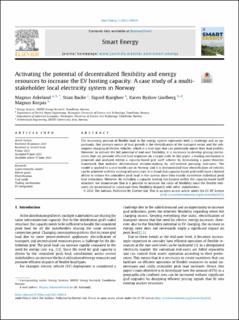| dc.contributor.author | Askeland, Magnus | |
| dc.contributor.author | Backe, Stian | |
| dc.contributor.author | Bjarghov, Sigurd | |
| dc.contributor.author | Lindberg, Karen Byskov | |
| dc.contributor.author | Korpås, Magnus | |
| dc.date.accessioned | 2022-03-18T09:39:11Z | |
| dc.date.available | 2022-03-18T09:39:11Z | |
| dc.date.created | 2021-12-03T12:14:36Z | |
| dc.date.issued | 2021 | |
| dc.identifier.issn | 2666-9552 | |
| dc.identifier.uri | https://hdl.handle.net/11250/2986116 | |
| dc.description.abstract | The increasing amount of flexible load in the energy system represents both a challenge and an opportunity. One primary source of load growth is the electrification of the transport sector and the subsequent charging of electric vehicles, which is a load type that can potentially adjust their load profiles. However, to activate the full potential of end-user flexibility, it is necessary to develop pricing mechanisms that can promote efficient load responses on a larger scale. In this paper, a trading mechanism is proposed and analysed within a capacity-based grid tariff scheme by formulating a game-theoretic framework that includes decentralized decision-making by self-interest pursuing end-users. The model is applied to a real-world case in Norway, and it is demonstrated how electrification of vehicles can be achieved with the existing infrastructure. It is found that capacity-based grid tariffs have a limited ability to reduce the coincident peak load in the system since they mainly incentivize individual peak load reductions. However, by including a capacity trading mechanism within the capacity-based tariff structure, we demonstrate that it is possible to increase the value of flexibility since the flexible end-users are incentivized to coordinate their flexibility dispatch with other stakeholders. | en_US |
| dc.language.iso | eng | en_US |
| dc.publisher | Elsevier | en_US |
| dc.relation.uri | https://doi.org/10.1016/j.segy.2021.100034 | |
| dc.rights | Navngivelse 4.0 Internasjonal | * |
| dc.rights.uri | http://creativecommons.org/licenses/by/4.0/deed.no | * |
| dc.title | Activating the potential of decentralized flexibility and energy resources to increase the EV hosting capacity: A case study of a multi-stakeholder local electricity system in Norway | en_US |
| dc.type | Peer reviewed | en_US |
| dc.type | Journal article | en_US |
| dc.description.version | publishedVersion | en_US |
| dc.source.volume | 3 | en_US |
| dc.source.journal | Smart Energy | en_US |
| dc.identifier.doi | 10.1016/j.segy.2021.100034 | |
| dc.identifier.cristin | 1964209 | |
| dc.relation.project | Norges forskningsråd: 257660 | en_US |
| dc.relation.project | Norges forskningsråd: 272398 | en_US |
| cristin.ispublished | true | |
| cristin.fulltext | original | |
| cristin.qualitycode | 1 | |

